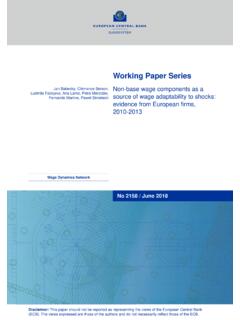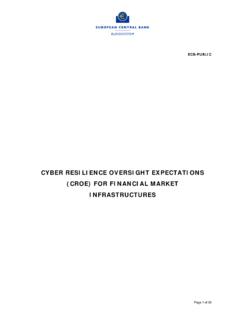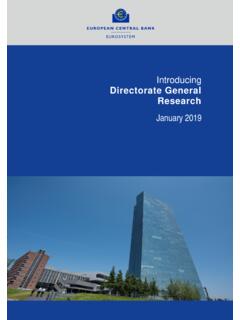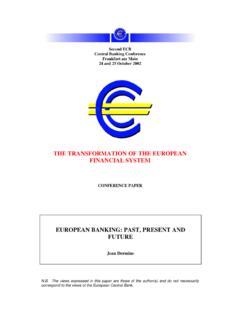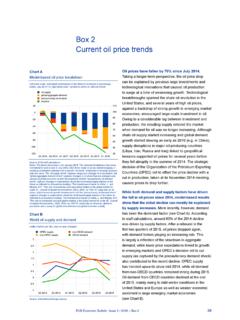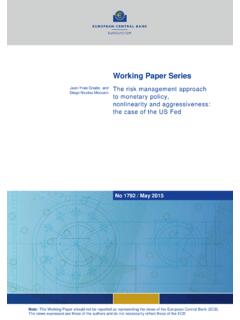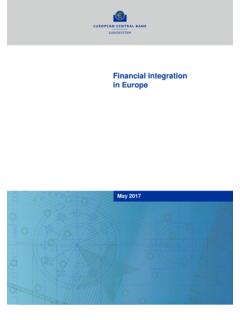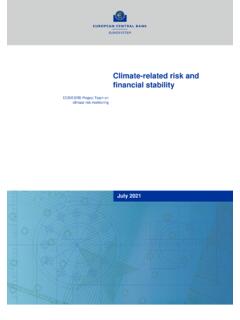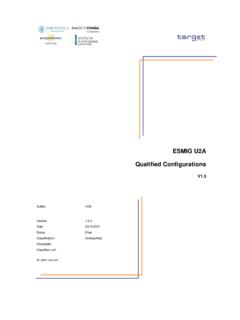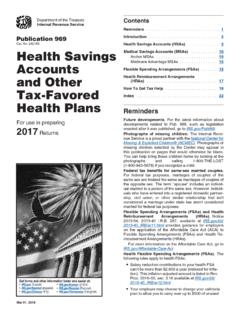Transcription of VIRTUAL CURRENCY SCHEMES, OCTOBER 2012 - Europa
1 V i r t ua l c u r r e n c y s c h e m e s O CT O B ER 2012. VIRTUAL CURRENCY SCHEMES. O cto b er 2012. In 2012 all ECB. publications feature a motif taken from the 50 banknote. European Central Bank, 2012. Address Kaiserstrasse 29. 60311 Frankfurt am Main Germany Postal address Postfach 16 03 19. 60066 Frankfurt am Main Germany Telephone +49 69 1344 0. Website Fax +49 69 1344 6000. All rights reserved. Reproduction for educational and non-commercial purposes is permitted provided that the source is acknowledged. ISBN: 978-92-899-0862-7 (online). CONTENTS. Executive summary 5. 1 Introduction 9. Preliminary remarks and motivation 9. A short historical review of money 9. Money in the VIRTUAL world 10. 2 VIRTUAL CURRENCY schemes 13. Definition and categorisation 13. VIRTUAL CURRENCY schemes and electronic money 16. Payment arrangements in VIRTUAL CURRENCY schemes 17. Reasons for implementing VIRTUAL CURRENCY schemes 18.
2 3 Case studies 21. The Bitcoin scheme 21. Basic features 21. Technical description of a Bitcoin transaction 23. Monetary aspects 24. Security incidents and negative press 25. The Second Life scheme 28. Basic features 28. Second Life economy 28. Monetary aspects 29. Issues with Second Life 30. 4 The relevance of VIRTUAL CURRENCY schemes for central banks 33. Risks to price stability 33. Risks to financial stability 37. Risks to payment system stability 40. Lack of regulation 42. Reputational risk 45. 5 Conclusion 47. Annex: References and further information on VIRTUAL CURRENCY SCHEMES 49. ECB. VIRTUAL CURRENCY schemes OCTOBER 2012 3. Executive summary VIRTUAL communities have proliferated in recent years a phenomenon triggered by technological developments and by the increased use of the internet. In some cases, these communities have created and circulated their own CURRENCY for exchanging the goods and services they offer, and thereby provide a medium of exchange and a unit of account for that particular VIRTUAL community.
3 This paper aims to provide some clarity on VIRTUAL currencies and tries to address the issue in a structured approach. It is important to take into account that these currencies both resemble money and necessarily come with their own dedicated retail payment systems; these two aspects are covered by the term VIRTUAL CURRENCY scheme . VIRTUAL CURRENCY schemes are relevant in several areas of the financial system and are therefore of interest to central banks. This, among other things, explains the ECB's interest in carrying out an analysis, especially in view of its role as a catalyst for payment systems and its oversight role. This report begins by defining and classifying VIRTUAL CURRENCY schemes based on observed characteristics; these might change in future, which could affect the current definition. A VIRTUAL CURRENCY can be defined as a type of unregulated, digital money, which is issued and usually controlled by its developers, and used and accepted among the members of a specific VIRTUAL community.
4 Depending on their interaction with traditional, real money and the real economy, VIRTUAL CURRENCY schemes can be classified into three types: Type 1, which is used to refer to closed VIRTUAL CURRENCY schemes, basically used in an online game; Type 2 VIRTUAL CURRENCY schemes have a unidirectional flow (usually an inflow), there is a conversion rate for purchasing the VIRTUAL CURRENCY , which can subsequently be used to buy VIRTUAL goods and services, but exceptionally also to buy real goods and services; and Type 3 VIRTUAL CURRENCY schemes have bidirectional flows, the VIRTUAL CURRENCY in this respect acts like any other convertible CURRENCY , with two exchange rates (buy and sell), which can subsequently be used to buy VIRTUAL goods and services, but also to purchase real goods and services. VIRTUAL CURRENCY schemes differ from electronic money schemes insofar as the CURRENCY being used as the unit of account has no physical counterpart with legal tender status.
5 The absence of a distinct legal framework leads to other important differences as well. Firstly, traditional financial actors, including central banks, are not involved. The issuer of the CURRENCY and scheme owner is usually a non-financial private company. This implies that typical financial sector regulation and supervision arrangements are not applicable. Secondly, the link between VIRTUAL CURRENCY and traditional CURRENCY ( CURRENCY with a legal tender status) is not regulated by law, which might be problematic or costly when redeeming funds, if this is even permitted. Lastly, the fact that the CURRENCY is denominated differently ( not euro, US dollar, etc.) means that complete control of the VIRTUAL CURRENCY is given to its issuer, who governs the scheme and manages the supply of money at will. There are several business reasons behind the establishment of VIRTUAL CURRENCY schemes.
6 They may provide a financial incentive for VIRTUAL community users to continue to participate, or create lock-in effects. Moreover, schemes are able to generate revenue for their owners, for instance float revenue. In addition, a VIRTUAL CURRENCY scheme, by allowing the VIRTUAL community owner to control its basic elements ( the creation of money and/or how to allocate funds), provides a high level of flexibility regarding the business model and business strategy for the VIRTUAL community. Finally, specifically for Type 3 schemes, a VIRTUAL CURRENCY scheme may also be implemented in order to compete with traditional currencies, such as the euro or the US dollar. ECB. VIRTUAL CURRENCY schemes OCTOBER 2012 5. The first case study in this report relates to Bitcoin, a VIRTUAL CURRENCY scheme based on a peer-to- peer network. It does not have a central authority in charge of money supply, nor a central clearing house, nor are financial institutions involved in the transactions, since users perform all these tasks themselves.
7 Bitcoins can be spent on both VIRTUAL and real goods and services. Its exchange rate with respect to other currencies is determined by supply and demand and several exchange platforms exist. The scheme has been surrounded by some controversy, not least because of its potential to become an alternative CURRENCY for drug dealing and money laundering as a result of its high degree of anonymity. The second case study in this report is Second Life's VIRTUAL CURRENCY scheme, in which Linden Dollars are used. This scheme can only be used within this VIRTUAL community for the purchase of VIRTUAL goods and services. Linden Lab manages the scheme and acts as issuer and transaction processor and ensures a stable exchange rate against the US dollar. However, the Second Life scheme has been subject to debate, and it has been suggested that this CURRENCY is more than simply money for online gaming.
8 Thereafter, a preliminary assessment is presented of the relevance of VIRTUAL CURRENCY schemes for central banks, paying attention mostly to schemes which are more open and linked to the real economy ( Type 3 schemes). The assessment covers the stability of prices, of the financial system and of the payment system, looking also at the regulatory perspective. It also addresses reputational risk concerns. It can be concluded that, in the current situation, VIRTUAL CURRENCY schemes: do not pose a risk to price stability, provided that money creation continues to stay at a low level;. tend to be inherently unstable, but cannot jeopardise financial stability, owing to their limited connection with the real economy, their low volume traded and a lack of wide user acceptance;. are currently not regulated and not closely supervised or overseen by any public authority, even though participation in these schemes exposes users to credit, liquidity, operational and legal risks.
9 Could represent a challenge for public authorities, given the legal uncertainty surrounding these schemes, as they can be used by criminals, fraudsters and money launderers to perform their illegal activities;. could have a negative impact on the reputation of central banks, assuming the use of such systems grows considerably and in the event that an incident attracts press coverage, since the public may perceive the incident as being caused, in part, by a central bank not doing its job properly;. do indeed fall within central banks' responsibility as a result of characteristics shared with payment systems, which give rise to the need for at least an examination of developments and the provision of an initial assessment. This report is a first attempt to provide the basis for a discussion on VIRTUAL CURRENCY schemes. Although these schemes can have positive aspects in terms of financial innovation and the provision ECB.
10 6 VIRTUAL CURRENCY schemes OCTOBER 2012. E x ecutive summary of additional payment alternatives to consumers, it is clear that they also entail risks. Owing to the small size of VIRTUAL CURRENCY schemes, these risks do not affect anyone other than users of the schemes. This assessment could change if usage increases significantly, for example if it were boosted by innovations which are currently being developed or offered. As a consequence, it is recommended that developments are regularly examined in order to reassess the risks. ECB. VIRTUAL CURRENCY schemes OCTOBER 2012 7. 1 Introduction Preliminary remarks and motivation This report seeks to provide clarity on the topic of VIRTUAL currencies and tries to address the issue in a structured approach. Such an approach has been absent, at least to some extent, from the existing literature. Moreover, there have previously been no references to this topic in the publications of central banks, international organisations or public authorities.
